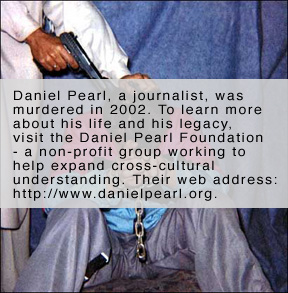
Office: HGH 210; phone: (408) 924-5378
Email: wooda@email.sjsu.edu
Web: http://www.sjsu.edu/faculty/wooda
 |
Dr. Andrew Wood Office: HGH 210; phone: (408) 924-5378 Email: wooda@email.sjsu.edu Web: http://www.sjsu.edu/faculty/wooda |
Grindstaff, D. A., & DeLuca, K.M. (2004). The corpus of Daniel Pearl. Critical Studies in Media Communication, 21(4), 305-324.
Note: These comments are not designed to "summarize" the reading. Rather, they are available to highlight key ideas that will emerge in our classroom discussion. As always, it's best to read the original text to gain full value from the course.
 Grindstaff
and DeLuca discuss the videotaped decapitation of U.S. journalist Daniel Pearl
as a synecdoche for the larger intersection of terrorism, nationalist
discourse, human bodies, and global media. The authors begin by discussing the
rhetorical features of terrorism, emphasizing first the way in which terrorism
is an interpretative term: “one person’s terrorist is another’s
freedom fighter, as the saying goes” (p. 307). In this section, the authors
argue that terrorism -- despite passing the threshold of violence -- is rhetorical
because of its staging of spectacles to generate publicity. Departing
from the overview of this article, I propose that we think carefully about whether
terrorism should be considered rhetorical and not simply symbolic. Either
way, the killing of Daniel Pearl resulted in a spectacle whose
reverberations continued long past his life.
Grindstaff
and DeLuca discuss the videotaped decapitation of U.S. journalist Daniel Pearl
as a synecdoche for the larger intersection of terrorism, nationalist
discourse, human bodies, and global media. The authors begin by discussing the
rhetorical features of terrorism, emphasizing first the way in which terrorism
is an interpretative term: “one person’s terrorist is another’s
freedom fighter, as the saying goes” (p. 307). In this section, the authors
argue that terrorism -- despite passing the threshold of violence -- is rhetorical
because of its staging of spectacles to generate publicity. Departing
from the overview of this article, I propose that we think carefully about whether
terrorism should be considered rhetorical and not simply symbolic. Either
way, the killing of Daniel Pearl resulted in a spectacle whose
reverberations continued long past his life.
Grindstaff and DeLuca then turn to an analysis of the National Movement for
the Restoration of Pakistan Sovereignty (NMRPS) whose members chose to murder
Pearl after forcing him to “confess” to his Jewish ancestry. The
authors write, “Pearl’s confession announces the transformation
of his body from an agent to a signifier of power” (p. 308). At this point,
Grindstaff and DeLuca shift their focus to Pakistani media responses to the
murder of an American Jew on their soil, noting how some newspapers condemned
the killing without necessarily condemning the cause by which Pearl died.
The authors change course once more to discuss how Pearl’s body became
rearticulated in the United States. After all, “The agency that has been
repeatedly stripped from the Pearl body must be re-invented and re-inscribed
upon the body itself” (p. 312). Here, the authors cite articles and letters
that defined Pearl as both an innocent in the vein of those who died in the
9/11 attacks and as a hero whose courage may be compared to that of firefighters
or even soldiers. At once, Pearl -- who avoided polemics, according to Grindstaff
and DeLuca -- becomes a symbol of American identity and a justification for
vengeance.
The essay continues by noting how Pakistan also confronted challenges to its
national identity in the wake of Pearl’s murder. This raised many questions,
including whether Pakistan should try the killers upon their capture or extradite
them to the United States. In a larger sense, the uproar raised anew the question
of whether Pakistan should serve as an ally in the U.S.-led War on Terror. Of
particular note is the fact that two Pakistani children were murdered in the
United States within days of Pearl’s killing, with little apparent notice
in our country: “The terrorizing of these Pakistani bodies . . . and their
invisibility on the American and international public screens, exacerbates Pakistani
anti-Americanism and complicates Pakistani national identity” (p. 316).
Of course, Pakistan is not alone is seeking to define itself in light of tragic
deaths.
Therefore, Grindstaff and DeLuca focus their last section on American nationalism
following Pearl’s murder, focusing on depictions of the killing. Questions
raised include: Should the U.S. media guard the “border” of American
popular culture by choosing not to show the video? Or should the media broadcast
the video as a symbol of the difference between us and them?
With these questions -- and the full essay -- the authors reveal how the human
body can become a complex and contested terrain of meaning when it becomes distilled
into a video image.
[Return to Syllabus]